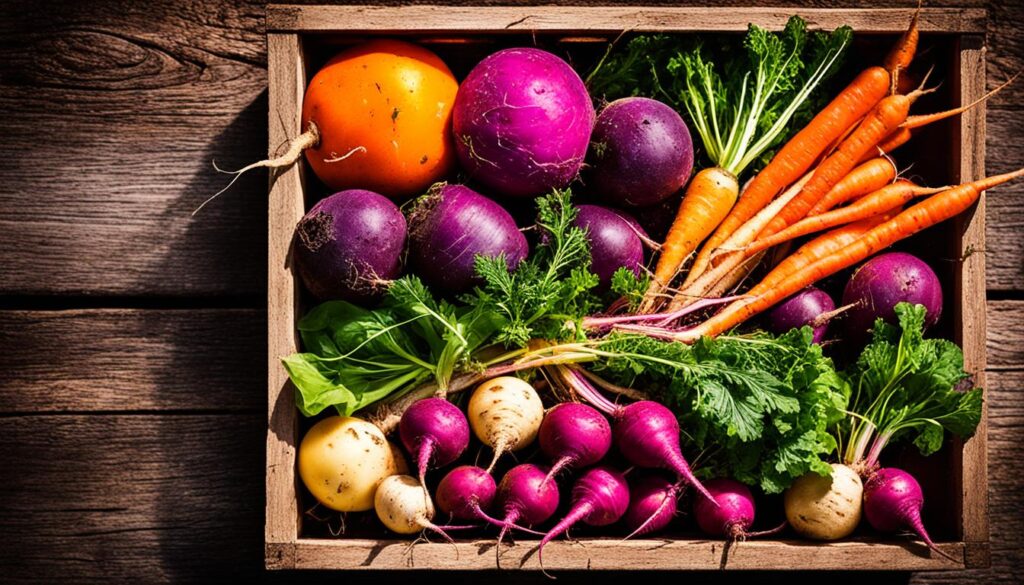
This article will look at how to get more hyaluronic acid from fruits, vegetables, and other foods. We’ll also talk about why the molecular weight of hyaluronic acid matters. Plus, we’ll see how it helps our skin and joints. Knowing where to find this substance can help you eat better for your health.
Dietary Sources of Hyaluronic Acid
The body makes some hyaluronic acid, but eating certain foods can also help. By eating foods high in this compound, people can keep their health in check. This is a great way to be proactive about your health.
There are many whole foods that have hyaluronic acid. Eating these foods can make your diet more varied. It also helps keep your hyaluronic acid levels up.
Nutritious Foods Containing Hyaluronic Acid
- Bone broth – Made from bones, cartilage, and connective tissue, bone broth is packed with hyaluronic acid.
- Organ meats – Foods like liver and heart have hyaluronic acid naturally.
- Soy products – Tofu, tempeh, and edamame are great plant-based sources of hyaluronic acid.
- Wheat – Whole wheat breads, pastas, and grains are good for hyaluronic acid.
- Root vegetables – Carrots, beets, and sweet potatoes are full of hyaluronic acid.

Fruits Rich in Hyaluronic Acid
Many fruits are great sources of hyaluronic acid. Citrus fruits and berries are especially good. They have a lot of this helpful compound.
Citrus Fruits
Oranges, lemons, and grapefruits are full of hyaluronic acid. They make eating more of this acid easy and tasty. They also give you important vitamins and nutrients.
Adding more citrus fruits to your daily meals is a tasty way to get more hyaluronic acid.
Berries
Berries like blueberries, strawberries, and raspberries are also great for hyaluronic acid. These fruits are full of antioxidants and help your skin, joints, and health. Eating different berries can help you get more hyaluronic acid easily and enjoyably.

Vegetables as Natural Sources of Hyaluronic Acid
Fruits are often seen as the go-to for hyaluronic acid. But, some vegetables, especially root veggies, are also packed with this important compound. Adding these veggies to your meals is a tasty way to boost your health.
Root Vegetables
Root veggies like carrots, sweet potatoes, and beets are full of hyaluronic acid. They grow underground, soaking up nutrients from the soil. This makes them great for a healthy diet.
- Carrots are a top choice for hyaluronic acid. They’re full of vitamins and antioxidants, plus they’re good for your skin and eyes.
- Sweet potatoes are loaded with hyaluronic acid too. They’re sweet, nutritious, and a tasty way to get more of this compound.
- Beets are another great option. They’re full of hyaluronic acid and have a unique flavor. They’re perfect for anyone looking to eat more vegetables rich in hyaluronic acid.
Adding these root vegetables to your meals is an easy way to get more hyaluronic acid. It’s a smart move for your health.
Dietary Supplements for Hyaluronic Acid
A balanced diet rich in hyaluronic acid is key for good health. Yet, some people might need extra help from supplements. These supplements can be a great addition to a healthy lifestyle, especially for those with certain health issues or goals.
Hyaluronic acid supplements come from sources like bacterial fermentation and animal extracts. They offer a high dose of hyaluronic acid. This can be good for supporting joint health, skin hydration, and other functions that need it.
When picking hyaluronic acid supplements, choose high-quality ones from trusted brands. Make sure they use studied forms of hyaluronic acid and don’t have fillers or harmful additives. Talk to a healthcare expert to find the right amount and make sure it fits your health needs.
Adding hyaluronic acid supplements to a diet full of nutrients can boost your health. By using both food sources and supplements, you can keep your hyaluronic acid levels right. This might help you enjoy its many benefits.

Delicious Root Vegetables: Underground Treasures
Root vegetables are the hidden gems of the plant world. They are full of flavor and nutrients. From the well-known carrots to the less common rutabagas, these veggies are versatile and nutritious. They are rich in vitamins, minerals, and fiber.
This article will dive into the world of root vegetables. We’ll look at their history, nutritional benefits, and many uses in cooking. This will help you improve your cooking and health.
Cooking with Root Vegetables: Techniques and Recipes
Mastering various cooking techniques can unlock the true potential of root vegetables. From roasting to mashing, each method brings out their unique flavors and textures. These underground treasures are full of surprises.
Begin by roasting veggies like carrots, beets, and potatoes to enhance their sweetness. Coat them in olive oil, season with salt and pepper, and roast at high heat. For a twist, try sautéing cubed root veggies with onions, garlic, and herbs.
For a cozy side dish, mash boiled root veggies with butter, milk, and nutmeg. Or, braise them in broth or wine for a rich flavor.
- Roasted Root Vegetable Medley: Toss diced carrots, parsnips, and sweet potatoes with olive oil, rosemary, and honey. Roast at 400°F until caramelized.
- Creamy Mashed Root Vegetables: Boil a mix of potatoes, turnips, and rutabaga. Mash with butter, milk, salt, and pepper for a silky smooth side dish.
- Braised Root Vegetables with Thyme: Sauté onions, then add cubed beets, celery root, and parsnips. Braise in chicken broth until tender and flavorful.

Nutritional Powerhouses Beneath the Earth
Root vegetables are more than just tasty; they’re nutritional powerhouses. They’re full of vitamins, minerals, and fiber, which are great for your health. Eating root vegetables can boost your immune system, help with digestion, and more.
| Root Vegetable | Nutrient Highlights | Health Benefits |
|---|---|---|
| Carrots | High in vitamin A, fiber, and antioxidants | Supports eye health, immune function, and skin health |
| Potatoes | Rich in complex carbohydrates, vitamin C, and potassium | Provides sustained energy, supports heart health, and regulates blood pressure |
| Beets | Abundant in folate, manganese, and nitrates | Enhances cognitive function, reduces inflammation, and supports detoxification |

Conclusion
Hyaluronic acid is a key compound found in many foods we eat. It’s in fruits, vegetables, and other foods we love. This substance is vital for our health and well-being.
Adding foods high in hyaluronic acid to our meals helps our skin, joints, and healing. Citrus fruits, berries, and root vegetables are great sources. They offer many benefits for our health.
Learning more about hyaluronic acid shows its importance for our bodies. Eating foods rich in it is a great way to stay healthy. By choosing these foods, we can improve our health and enjoy a better life.

